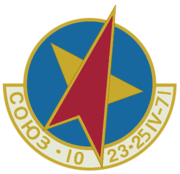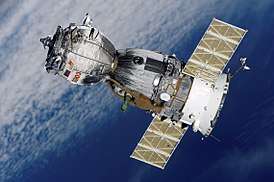Soyuz 10
Soyuz 10 (Russian: 'Союз 10', Union 10) was launched on 22 April 1971 as the world's first mission to the world's first space station, the Soviet Salyut 1. The docking was not successful and the crew returned to Earth without having entered the station. It would be the first of numerous docking failures in the Soviet space station program.[4]
| Operator | Soviet space program |
|---|---|
| COSPAR ID | 1971-034A |
| SATCAT no. | 5172 |
| Mission duration | 1 day, 23 hours, 45 minutes, 54 seconds |
| Orbits completed | 32 |
| Spacecraft properties | |
| Spacecraft type | Soyuz 7K-OKS |
| Manufacturer | Experimental Design Bureau OKB-1 |
| Launch mass | 6,800 kilograms (15,000 lb) |
| Crew | |
| Crew size | 3 |
| Members | Vladimir Shatalov Aleksei Yeliseyev Nikolai Rukavishnikov |
| Callsign | Гранит (Granit - "Granite")[1] |
| Start of mission | |
| Launch date | 22 April 1971, 23:54:06 UTC |
| Rocket | Soyuz |
| Launch site | Baikonur 1/5[2] |
| End of mission | |
| Landing date | 24 April 1971, 23:40:00 UTC |
| Landing site | 120 kilometres (75 mi) NW of Karaganda |
| Orbital parameters | |
| Reference system | Geocentric |
| Regime | Low Earth |
| Perigee altitude | 209 kilometres (130 mi) |
| Apogee altitude | 258 kilometres (160 mi) |
| Inclination | 51.6 degrees |
| Period | 89.1 minutes |
| Epoch | 23 April 1971[3] |
 Soyuz programme (Crewed missions) | |
Orbit
Soyuz 10 was launched on 22 April 1971 to dock with Salyut 1. The spacecraft was the first of the upgraded Soyuz 7K-OKS, featuring the new "probe and drogue" docking mechanism with internal crew transfer capability, intended for space station visits.
Mission
The cosmonauts Vladimir Shatalov, Aleksei Yeliseyev, and Nikolai Rukavishnikov were able to navigate their Soyuz 10 spacecraft to the Salyut 1 station, yet during docking they ran into problems. The automatic control system failed during approach, owing to a serious design oversight: when soft dock was performed, the computer sensed an abnormality in the spacecraft's alignment and began firing the attitude control jets to compensate. With Soyuz 10 being pushed to one side by the attitude control system, it became impossible to achieve hard dock, and large quantities of propellant were expended doing so. The docking attempt was called off, but further difficulty occurred when the probe would not come out of the space station's docking cone. The obvious solution was simply to jettison the orbital module and leave it attached to Salyut 1, but this would make it impossible for future Soyuz missions to dock; thus, the space station would have to be abandoned. Eventually, ground controllers realized that the cosmonauts could throw a circuit breaker in the docking mechanism, for interrupting the power supply would cause the probe to automatically retract. This procedure worked, and undocking was completed.[1] The automatic control system would be redesigned on future Soyuz spacecraft.
After finally undocking, one last hitch presented itself when toxic fumes began to fill the capsule during reentry, causing Rukavishnikov to pass out; however, all three crew members were recovered unscathed.
Crew
| Position | Cosmonaut | |
|---|---|---|
| Commander | Vladimir Shatalov Third and last spaceflight | |
| Flight Engineer | Aleksei Yeliseyev Third and last spaceflight | |
| Test Engineer | Nikolai Rukavishnikov First spaceflight | |
Backup crew
| Position | Cosmonaut | |
|---|---|---|
| Commander | Alexei Leonov | |
| Flight Engineer | Valeri Kubasov | |
| Test Engineer | Pyotr Kolodin | |
Reserve crew
| Position[1] | Cosmonaut | |
|---|---|---|
| Commander | Georgi Dobrovolski | |
| Flight Engineer | Vladislav Volkov | |
| Test Engineer | Viktor Patsayev | |
See also
- Soyuz T-13, a mission to manually dock to the crippled Salyut 7 space station.
- Soyuz T-15, a mission to ferry equipment from Salyut 7 to Mir, which had to manually maneuver and dock to Mir.
References
- Mir Hardware Heritage - 1.7.3 (wikisource)
- "Baikonur LC1". Encyclopedia Astronautica. Archived from the original on 2009-04-15. Retrieved 2009-03-04.
- McDowell, Jonathan. "SATCAT". Jonathan's Space Pages. Retrieved 23 March 2014.
- The mission report is available here: http://www.spacefacts.de/mission/english/soyuz-10.htm
